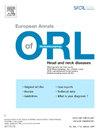面瘫对化妆习惯的影响:一项观察性队列研究。
IF 2.4
4区 医学
Q2 OTORHINOLARYNGOLOGY
European Annals of Otorhinolaryngology-Head and Neck Diseases
Pub Date : 2024-11-01
DOI:10.1016/j.anorl.2024.05.002
引用次数: 0
摘要
目的:外周血管疾病(PFP)所固有的美观问题经常引起人们的抱怨。化妆被认为是一种治疗方式,可以缓解抑郁症状。本研究旨在收集 PFP 女性患者的化妆习惯数据,并评估其与美学和/或功能性投诉之间的联系:为了比较 PFP 女性患者和普通女性的化妆习惯,我们制作了两份问卷。第一份问卷于2019年9月至12月间发给39名House-Brackmann III级PFP患者(A组),第二份在线问卷发给1385名对照组女性(B组):结果:PFP患者在周末(χ2=16.38;P=0.0009)和在家时(χ2=8.21;P=0.042)比对照组更常使用化妆品,更常使用粉底(χ2=17.21;P=0.0006)和唇部化妆品(χ2=59.31;P=0.042):本研究中发现的化妆品使用差异旨在掩盖面部麻痹,与美学投诉有关,影响了社交生活。本文章由计算机程序翻译,如有差异,请以英文原文为准。
Impact of facial palsy impact on make-up habits: An observational cohort study
Objective
The esthetic problems inherent to peripheral (PFP) are frequent causes of complaint. Make-up is advocated as a form of therapy and can alleviate symptoms of depression. The aim of the present study was to collect data on make-up habits in female PFP patients and assess links with esthetic and/or functional complaints.
Material and methods
Two questionnaires were drawn up to compare make-up habits in female PFP patients and women in the general population. The first was sent out between September and December 2019, to 39 House-Brackmann grade III PFP patients (group A), and the second on-line questionnaire was sent to a control population of 1385 women (group B).
Results
PFP patients used make-up more often than controls at weekends (χ2 = 16.38; P = 0.0009) and while at home (χ2 = 8.21; P = 0.042), and more often with foundation (χ2 = 17.21; P = 0.0006) and lip make-up (χ2 = 59.31; P < 0.0001). The greater their functional complaint, the less they made up their eyes. The greater their self-confidence and the more they felt attractive, the less they made up their lips.
Conclusion
The differences in make-up use found in the present study aimed to mask facial palsy and were related to the esthetic complaint, impacting social life.
求助全文
通过发布文献求助,成功后即可免费获取论文全文。
去求助
来源期刊

European Annals of Otorhinolaryngology-Head and Neck Diseases
OTORHINOLARYNGOLOGY-
CiteScore
3.70
自引率
28.00%
发文量
97
审稿时长
12 days
期刊介绍:
European Annals of Oto-rhino-laryngology, Head and Neck diseases heir of one of the oldest otorhinolaryngology journals in Europe is the official organ of the French Society of Otorhinolaryngology (SFORL) and the the International Francophone Society of Otorhinolaryngology (SIFORL). Today six annual issues provide original peer reviewed clinical and research articles, epidemiological studies, new methodological clinical approaches and review articles giving most up-to-date insights in all areas of otology, laryngology rhinology, head and neck surgery. The European Annals also publish the SFORL guidelines and recommendations.The journal is a unique two-armed publication: the European Annals (ANORL) is an English language well referenced online journal (e-only) whereas the Annales Françaises d’ORL (AFORL), mail-order paper and online edition in French language are aimed at the French-speaking community. French language teams must submit their articles in French to the AFORL site.
Federating journal in its field, the European Annals has an Editorial board of experts with international reputation that allow to make an important contribution to communication on new research data and clinical practice by publishing high-quality articles.
 求助内容:
求助内容: 应助结果提醒方式:
应助结果提醒方式:


